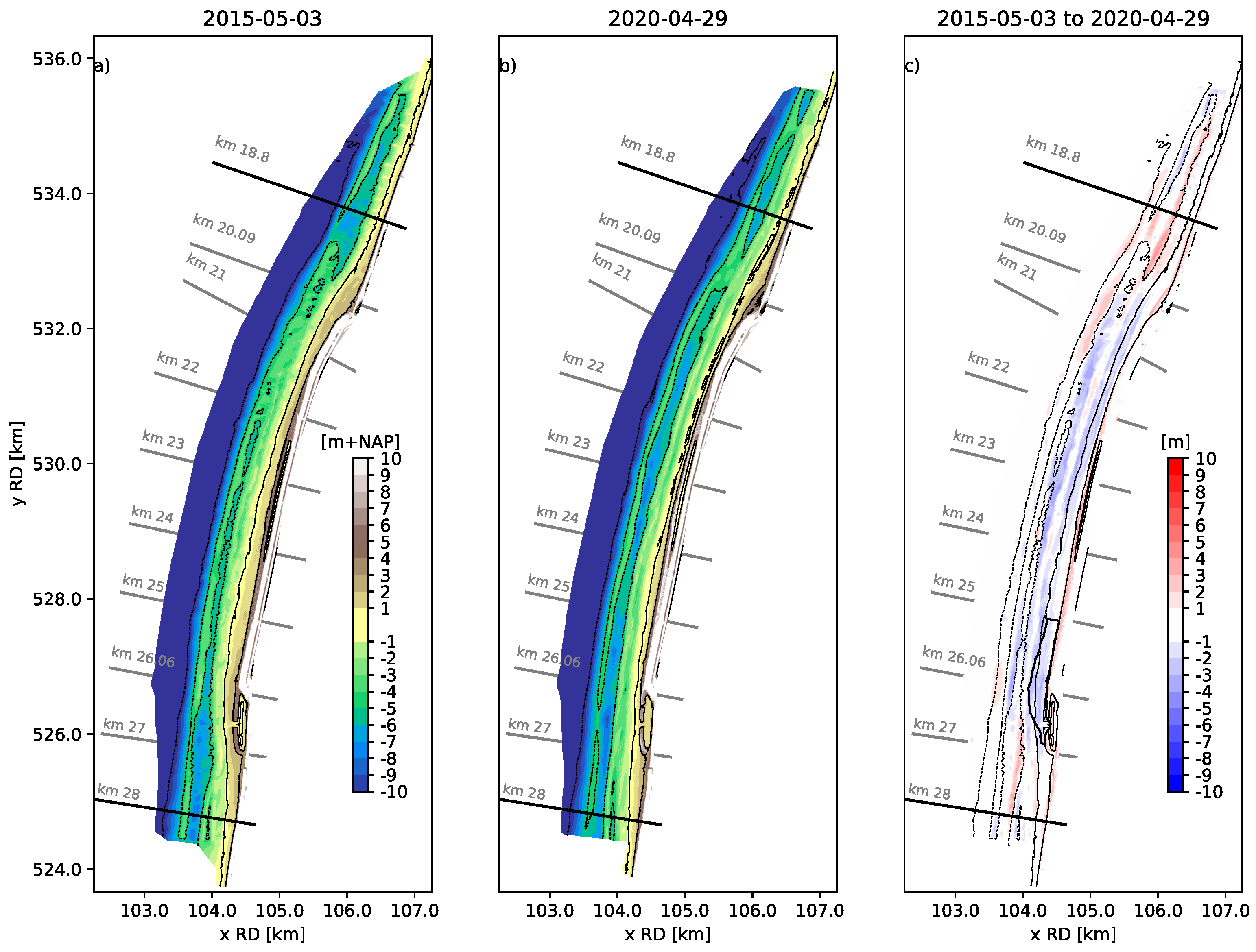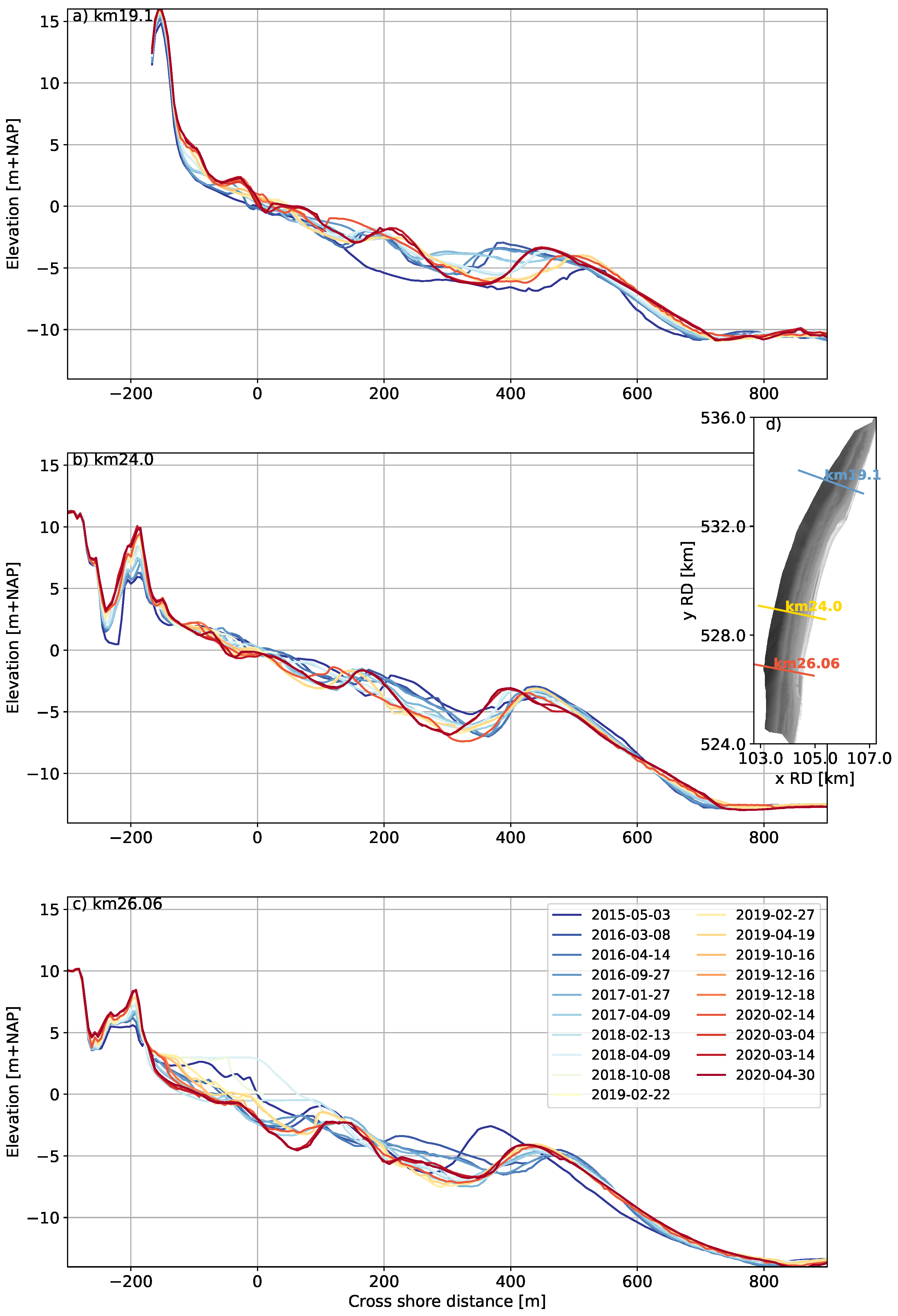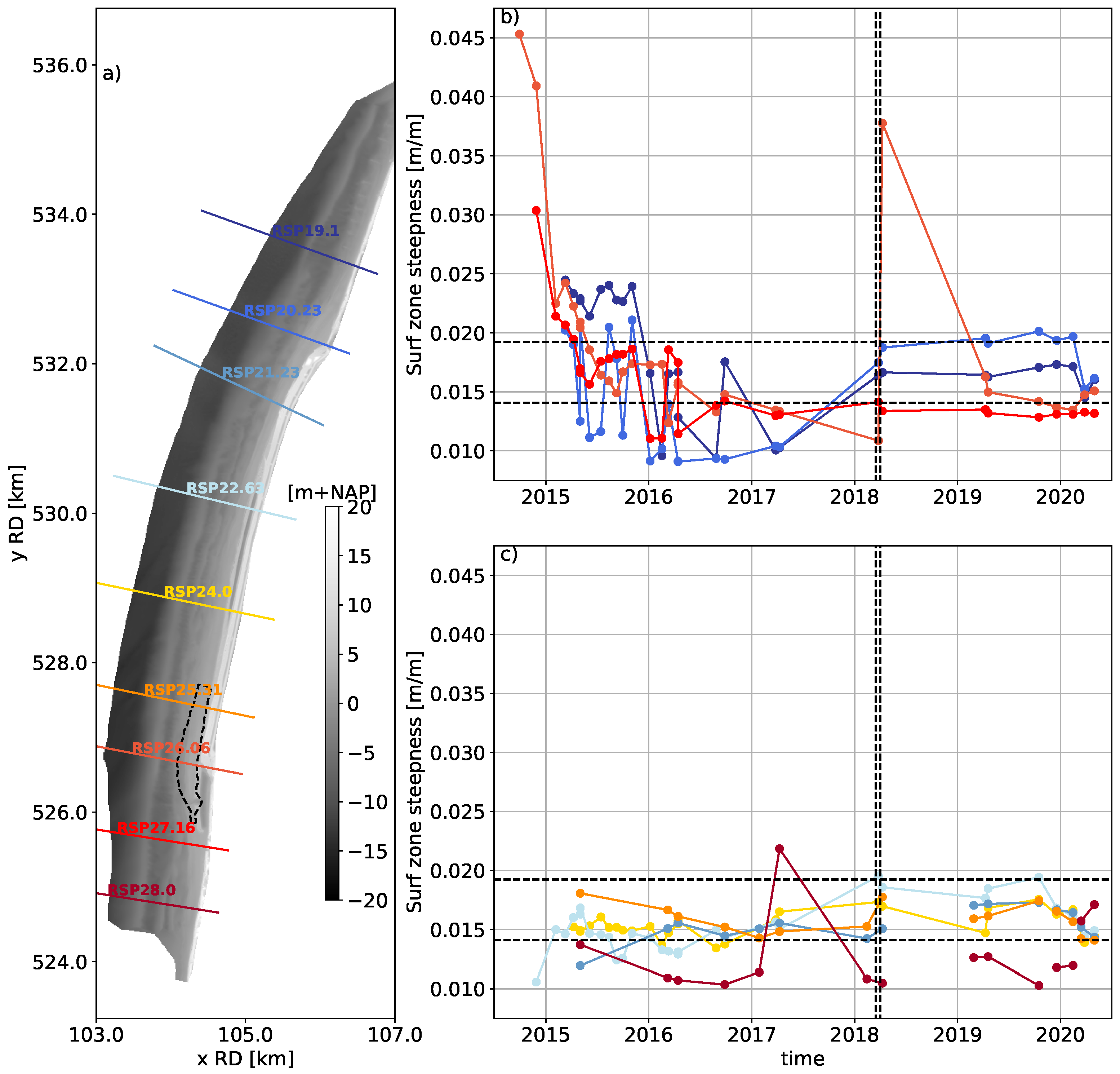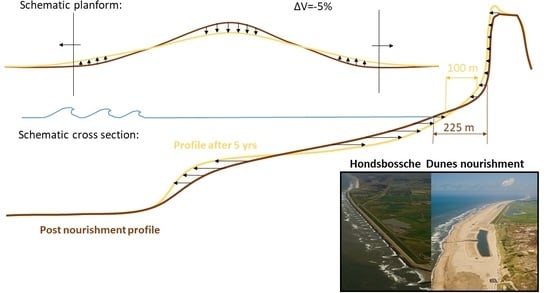Subaqueous and Subaerial Beach Changes after Implementation of a Mega Nourishment in Front of a Sea Dike
Abstract
:1. Introduction
2. Case Study
2.1. Coastal Setting

2.2. Hondsbossche Dunes Nourishment
3. Methodology
3.1. Morphological Datasets
3.2. Data Reduction
3.2.1. Sediment Volumes at Different Elevations in the Profile
3.2.2. Beach Width, Shoreline Position, and Dune Foot
3.2.3. Surfzone Slope
3.2.4. Coastline Curvature
4. Results
4.1. General Morphodynamic Response of the Nourished Beach in Five Years
4.2. Volumetric Changes
4.3. Changes in Perspective of the Morphodynamics of the Coastal Cell
4.4. Cross-Shore Adaptation
4.5. Subaerial Evolution
4.6. Profile Volumes and Beach Width Changes as Function of Coastline Curvature
5. Discussion
5.1. Beach Width and Dune Growth
5.2. Predicting Beach Width and Volume Change
5.3. Implications for Design
6. Conclusions
Author Contributions
Funding
Data Availability Statement
Acknowledgments
Conflicts of Interest
References
- Nicholls, R.J.; Cazenave, A. Sea-level rise and its impact on coastal zones. Science 2010, 328, 1517–1520. [Google Scholar] [CrossRef]
- Hinkel, J.; Aerts, J.C.; Brown, S.; Jiménez, J.A.; Lincke, D.; Nicholls, R.J.; Scussolini, P.; Sanchez-Arcilla, A.; Vafeidis, A.; Addo, K.A. The ability of societies to adapt to twenty-first-century sea-level rise. Nat. Clim. Chang. 2018, 8, 570–578. [Google Scholar] [CrossRef]
- Dean, R.G. Beach Nourishment: Theory and Practice; World Scientific: Singapore, 2002. [Google Scholar]
- de Schipper, M.A.; Ludka, B.C.; Raubenheimer, B.; Luijendijk, A.P.; Schlacher, T.A. Beach nourishment has complex implications for the future of sandy shores. Nat. Rev. Earth Environ. 2021, 2, 70–84. [Google Scholar] [CrossRef]
- Ton, A.; Vuik, V.; Aarninkhof, S. Longshore sediment transports by large-scale lake circulations at low-energy, non-tidal beaches: A field and model study. Coast. Eng. 2022, submitted.
- Perk, L.; van Rijn, L.; Koudstaal, K.; Fordeyn, J. A rational method for the design of sand dike/dune systems at sheltered sites; Wadden Sea Coast of Texel, The Netherlands. J. Mar. Sci. Eng. 2019, 7, 324. [Google Scholar] [CrossRef] [Green Version]
- Vuik, V.; Jonkman, S.N.; Borsje, B.W.; Suzuki, T. Nature-based flood protection: The efficiency of vegetated foreshores for reducing wave loads on coastal dikes. Coast. Eng. 2016, 116, 42–56. [Google Scholar] [CrossRef] [Green Version]
- Bridges, T.S.; Bourne, E.M.; King, J.K.; Kuzmitski, H.K.; Moynihan, E.B.; Suedel, B.C. Engineering with Nature: An Atlas; U.S. Army Engineer Research and Development Center: Vicksburg, MI, USA, 2018. [Google Scholar] [CrossRef]
- de Vriend, H.J.; van Koningsveld, M.; Aarninkhof, S.G.J.; de Vries, M.B.; Baptist, M.J. Sustainable hydraulic engineering through building with nature. J. Hydro-Environ. Res. 2015, 9, 159–171. [Google Scholar] [CrossRef]
- Brand, E.; Ramaekers, G.; Lodder, Q. Dutch experience with sand nourishments for dynamic coastline conservation—An operational overview. Ocean. Coast. Manag. 2022, 217, 106008. [Google Scholar] [CrossRef]
- Stive, M.; de Schipper, M.; Luijendijk, A.; Aarninkhof, S.; van Gelder-Maas, C.; van Thiel De Vries, J.; de Vries, S.; Henriquez, M.; Marx, S.; Ranasinghe, R. A New Alternative to Saving Our Beaches from Sea-Level Rise: The Sand Engine. J. Coast. Res 2013, 29, 1001–1008. [Google Scholar] [CrossRef]
- de Schipper, M.A.; de Vries, S.; Ruessink, G.; de Zeeuw, R.C.; Rutten, J.; van Gelder-Maas, C.; Stive, M.J.F. Initial spreading of a mega feeder nourishment: Observations of the Sand Engine pilot project. Coast. Eng. 2016, 111, 23–38. [Google Scholar] [CrossRef] [Green Version]
- Pelnard-Considère, R. Essai de théorie de l’évolution des formes de rivage en plages de sable et de galets. Journées de l’hydraulique 1957, 4, 289–298. [Google Scholar]
- Ludka, B.C.; Guza, R.T.; O’Reilly, W.C. Nourishment evolution and impacts at four southern California beaches: A sand volume analysis. Coast. Eng. 2018, 136, 96–105. [Google Scholar] [CrossRef]
- Liu, G.; Cai, F.; Qi, H.; Zhu, J.; Lei, G.; Cao, H.; Zheng, J. A method to nourished beach stability assessment: The case of China. Ocean. Coast. Manag. 2019, 177, 166–178. [Google Scholar] [CrossRef]
- Elko, N.A.; Wang, P. Immediate profile and planform evolution of a beach nourishment project with hurricane influences. Coast. Eng. 2007, 54, 49–66. [Google Scholar] [CrossRef]
- Chang, J.I.; Yoon, S. The economic benefit of coastal erosion control in Korea. J. Coast. Res. 2016, 1, 1317–1321. [Google Scholar] [CrossRef]
- Liu, Z.; Cui, B.; He, Q. Shifting paradigms in coastal restoration: Six decades’ lessons from China. Sci. Total. Environ. 2016, 566–567, 205–214. [Google Scholar] [CrossRef] [Green Version]
- Gopalakrishnan, S.; Smith, M.D.; Slott, J.M.; Murray, A.B. The value of disappearing beaches: A hedonic pricing model with endogenous beach width. J. Environ. Econ. Manag. 2011, 61, 297–310. [Google Scholar] [CrossRef] [Green Version]
- de Vries, S.; Arens, S.; De Schipper, M.; Ranasinghe, R. Aeolian sediment transport on a beach with a varying sediment supply. Aeolian Res. 2014, 15, 235–244. [Google Scholar] [CrossRef]
- Walker, I.J.; Davidson-Arnott, R.G.; Bauer, B.O.; Hesp, P.A.; Delgado-Fernandez, I.; Ollerhead, J.; Smyth, T.A. Scale-dependent perspectives on the geomorphology and evolution of beach-dune systems. Earth-Sci. Rev. 2017, 171, 220–253. [Google Scholar] [CrossRef]
- Bauer, B.; Davidson-Arnott, R.; Hesp, P.; Namikas, S.; Ollerhead, J.; Walker, I. Aeolian sediment transport on a beach: Surface moisture, wind fetch, and mean transport. Geomorphology 2009, 105, 106–116. [Google Scholar] [CrossRef]
- Bruun, P. Coast Erosion and the Development of Beach Profiles; Beach Erosion Board: Washington, DC, USA, 1954. [Google Scholar]
- Dean, R.G. Equilibrium beach profiles: Characteristics and applications. J. Coast. Res. 1991, 7, 53–84. [Google Scholar]
- Galiforni Silva, F.; Wijnberg, K.M.; de Groot, A.V.; Hulscher, S.J. The effects of beach width variability on coastal dune development at decadal scales. Geomorphology 2019, 329, 58–69. [Google Scholar] [CrossRef] [Green Version]
- van Puijenbroek, M.E.; Limpens, J.; de Groot, A.V.; Riksen, M.J.; Gleichman, M.; Slim, P.A.; van Dobben, H.F.; Berendse, F. Embryo dune development drivers: Beach morphology, growing season precipitation, and storms. Earth Surf. Process. Landf. 2017, 42, 1733–1744. [Google Scholar] [CrossRef]
- Hoonhout, B.; de Vries, S. Aeolian sediment supply at a mega nourishment. Coast. Eng. 2017, 123, 11–20. [Google Scholar] [CrossRef] [Green Version]
- Smyth, T.A.; Hesp, P.A. Aeolian dynamics of beach scraped ridge and dyke structures. Coast. Eng. 2015, 99, 38–45. [Google Scholar] [CrossRef] [Green Version]
- Moulton, M.A.; Hesp, P.A.; Miot da Silva, G.; Keane, R.; Fernandez, G.B. Surfzone-beach-dune interactions along a variable low wave energy dissipative beach. Mar. Geol. 2021, 435, 106438. [Google Scholar] [CrossRef]
- Thornton, E.B.; MacMahan, J.; Sallenger, A.H. Rip currents, mega-cusps, and eroding dunes. Mar. Geol. 2007, 240, 151–167. [Google Scholar] [CrossRef]
- Cohn, N.; Ruggiero, P.; de Vries, S.; Kaminsky, G.M. New insights on coastal foredune growth: The relative contributions of marine and aeolian processes. Geophys. Res. Lett. 2018, 45, 4965–4973. [Google Scholar] [CrossRef]
- Wijnberg, K.M.; Terwindt, J.H.J. Extracting decadal morphological behaviour from high-resolution, long-term bathymetric surveys along the Holland coast using eigenfunction analysis. Mar. Geol. 1995, 126, 301–330. [Google Scholar] [CrossRef]
- Wijnberg, K.M. Environmental controls on decadal morphologic behaviour of the Holland coast. Mar. Geol. 2002, 189, 227–247. [Google Scholar] [CrossRef]
- Technische Adviescommissie voor de Waterkeringen. Leidraad voor de Beoordeling van Duinen als Waterkering; Technische Adviescommissie voor de Waterkeringen: The Hague, The Netherlands, 1984. [Google Scholar]
- van Alphen, J. De Morfologie en Lithologie van de Brandingszone Tussen Terheijde en Egmond aan Zee; Technical Report NZ-N-87.28; Rijkswaterstaat: Utrecht, The Netherlands, 1987.
- Kroon, A.; van Leeuwen, B.; Walstra, D.J.; Loman, G. Dealing with Uncertainties in Long-term Predictions of a Coastal Nourishment. In Coastal Management: Changing Coast, Changing Climate, Changing Minds; ICE Publishing: London, UK, 2016; pp. 9–18. [Google Scholar] [CrossRef]
- Rijkswaterstaat. Kenmerkende Waarden, Getijgebied 2011.0; RWS Centrale Informatievoorziening: Delft, The Netherlands, 2013.
- van Rijn, L.C. Sediment transport and budget along the Dutch coastal zone. Coast. Eng. 1997, 32, 61–90. [Google Scholar] [CrossRef]
- Rijkswaterstaat. Kustlijnkaartenboek 2019; Ministerie van Infrastructuur en Waterstaat, Rijkswaterstaat: Utrecht, The Netherlands, 2018.
- Rijkswaterstaat. Kustlijnkaartenboek 2021; Ministerie van Infrastructuur en Waterstaat, Rijkswaterstaat: Utrecht, The Netherlands, 2020.
- Rijkswaterstaat. Nourishments along the Dutch Coast Since 1952. Available online: https://opendap.deltares.nl/thredds/catalog/opendap/rijkswaterstaat/suppleties/catalog.html (accessed on 12 April 2021).
- van Gent, M.R.; van Thiel de Vries, J.S.; Coeveld, E.M.; de Vroeg, J.H.; van de Graaff, J. Large-scale dune erosion tests to study the influence of wave periods. Coast. Eng. 2008, 55, 1041–1051. [Google Scholar] [CrossRef]
- Den Heijer, C.K.; Baart, F.; van Koningsveld, M. Assessment of dune failure along the Dutch coast using a fully probabilistic approach. Geomorphology 2012, 143–144, 95–103. [Google Scholar] [CrossRef]
- Rijkswaterstaat. Annual Cross-Shore Transect Bathymetry Measurements along the Dutch Coast Since 1965. Available online: https://opendap.deltares.nl/thredds/catalog/opendap/rijkswaterstaat/jarkus/profiles/catalog.html (accessed on 9 February 2021).
- de Vries, S.; Southgate, H.N.; Kanning, W.; Ranasinghe, R. Dune behavior and aeolian transport on decadal timescales. Coast. Eng. 2012, 67, 41–53. [Google Scholar] [CrossRef]
- Smith, A.; Houser, C.; Lehner, J.; George, E.; Lunardi, B. Crowd-sourced identification of the beach-dune interface. Geomorphology 2020, 367, 107321. [Google Scholar] [CrossRef]
- Quartel, S.; Kroon, A.; Ruessink, B.G. Seasonal accretion and erosion patterns of a microtidal sandy beach. Mar. Geol. 2008, 250, 19–33. [Google Scholar] [CrossRef]
- Ludka, B.C.; Gallien, T.W.; Crosby, S.C.; Guza, R.T. Mid-El Niño erosion at nourished and unnourished Southern California beaches. Geophys. Res. Lett. 2016, 43, 4510–4516. [Google Scholar] [CrossRef] [Green Version]
- Yates, M.L.; Guza, R.T.; O’Reilly, W.C. Equilibrium shoreline response: Observations and modeling. J. Geophys. Res. Ocean. 2009, 114. [Google Scholar] [CrossRef] [Green Version]
- Griggs, G.B.; Patsch, K. Natural changes and human impacts on the sand budgets and beach widths of the Zuma and Santa Monica littoral cells, Southern California. Shore Beach 2018, 86, 1–14. [Google Scholar]
- Park, J.Y.; Gayes, P.T.; Wells, J.T. Monitoring Beach Renourishment along the Sediment-Starved Shoreline of Grand Strand, South Carolina. J. Coast. Res. 2009, 25, 336–349. [Google Scholar] [CrossRef]
- Marinho, B.; Coelho, C.; Larson, M.; Hanson, H. Short- and long-term responses of nourishments: Barra-Vagueira coastal stretch, Portugal. J. Coast. Conserv. 2018, 22, 475–489. [Google Scholar] [CrossRef]
- Larson, M.; Hanson, H.; Kraus, N.C.; Newe, J. Short- and long- term responses of beach fills determined by eof analysis. J. Waterw. Port Coasta Ocean Eng. 1999, 125, 285–293. [Google Scholar] [CrossRef]
- Browder, A.E.; Dean, R.G. Monitoring and comparison to predictive models of the Perdido Key beach nourishment project, Florida, USA. Coast. Eng. 2000, 39, 173–191. [Google Scholar] [CrossRef]
- Roest, B.; de Vries, S.; de Schipper, M.; Aarninkhof, S. Observed changes of a mega feeder nourishment in a coastal cell: Five years of sand engine morphodynamics. J. Mar. Sci. Eng. 2021, 9, 37. [Google Scholar] [CrossRef]
- Verhagen, H.J. Analysis of beach nourishment schemes. J. Coast. Res. 1996, 12, 179–185. [Google Scholar]
- Dean, R.G.; Yoo, C. Beach-Nourishment Performance Predictions. J. Waterw. Port Coast. Ocean. Eng. 1992, 118, 567–586. [Google Scholar] [CrossRef]
- Bezzi, A.; Fontolan, G.; Nordstrom, K.F.; Carrer, D.; Jackson, N.L. Beach nourishment and foredune restoration: Practices and constraints along the venetian Shoreline, Italy. J. Coast. Res. 2009, 1, 287–291. [Google Scholar]
- Cohn, N.; Ruggiero, P.; García-Medina, G.; Anderson, D.; Serafin, K.A.; Biel, R. Environmental and morphologic controls on wave-induced dune response. Geomorphology 2019, 329, 108–128. [Google Scholar] [CrossRef] [Green Version]
- Itzkin, M.; Moore, L.J.; Ruggiero, P.; Hacker, S.D.; Biel, R.G. The relative influence of dune aspect ratio and beach width on dune erosion as a function of storm duration and surge level. Earth Surf. Dyn. 2021, 9, 1223–1237. [Google Scholar] [CrossRef]
- van der Wal, D. Beach-Dune Interactions in Nourishment Areas along the Dutch Coast. J. Coast. Res. 2004, 20, 317–325. [Google Scholar] [CrossRef]
- Athanasiou, P.; van Dongeren, A.; Giardino, A.; Vousdoukas, M.; Antolinez, J.A.; Ranasinghe, R. A Clustering Approach for Predicting Dune Morphodynamic Response to Storms Using Typological Coastal Profiles: A Case Study at the Dutch Coast. Front. Mar. Sci. 2021, 8, 747754. [Google Scholar] [CrossRef]
- den Heijer, C. The Role of Bathymetry, Wave Obliquity and Coastal Curvature in Dune Erosion Prediction. Ph.D. Thesis, Delft University of Technology, Delft, The Netherlands, 2013. [Google Scholar]
- Silva, F.G.; Wijnberg, K.M.; de Groot, A.V.; Hulscher, S.J.M.H. On the importance of tidal inlet processes for coastal dune development. Coast. Dyn. Proc. 2017, 104, 106–110. [Google Scholar] [CrossRef]
- Wijnberg, K.; Poppema, D.; Mulder, J.; van Bergen, J.; Campmans, G.; Galiforni-Silva, F.; Hulscher, S.; Pourteimouri, P. Beach-dune modelling in support of Building with Nature for an integrated spatial design of urbanized sandy shores. Res. Urban. Ser. 2021, 7, 241–259. [Google Scholar] [CrossRef]
- de Vries, S.; van Thiel de Vries, J.S.; van Rijn, L.C.; Arens, S.M.; Ranasinghe, R. Aeolian sediment transport in supply limited situations. Aeolian Res. 2014, 12, 75–85. [Google Scholar] [CrossRef]
- Thieler, E.R.; Pilkey, O.H.; Young, R.S.; Bush, D.M.; Chai, F. The use of mathematical models to predict beach behavior for U.S. coastal engineering: A critical review. J. Coast. Res. 2000, 16, 48–70. [Google Scholar]
- Ranasinghe, R. On the need for a new generation of coastal change models for the 21st century. Sci. Rep. 2020, 10, 2010. [Google Scholar] [CrossRef] [PubMed]
- Weathers, H.; Voulgaris, G. Evaluation of beach nourishment evolution models using data from two South Carolina, USA beaches: Folly Beach and Hunting Island. J. Coast. Res. 2013, 69, 84–98. [Google Scholar] [CrossRef]
- Hanson, H. Genesis-A Generalized Shoreline Change Numerical Model. J. Coast. Res. 1988, 5, 1–27. [Google Scholar]
- Dabees, M.; Kamphuis, J.W. ONELINE, a numerical model for shoreline change. Proc. Int. Conf. Coast. Eng. 1998, 1, 2668–2681. [Google Scholar]
- Hurst, M.D.; Barkwith, A.; Ellis, M.A.; Thomas, C.W.; Murray, A.B. Exploring the sensitivities of crenulate bay shorelines to wave climates using a new vector-based one-line model. J. Geophys. Res. Earth Surf. 2015, 120, 2586–2608. [Google Scholar] [CrossRef] [Green Version]
- Roelvink, D.; Huisman, B.; Elghandour, A.; Ghonim, M.; Reyns, J. Efficient Modeling of Complex Sandy Coastal Evolution at Monthly to Century Time Scales. Front. Mar. Sci. 2020, 7, 535. [Google Scholar] [CrossRef]
- Hallermeier, R.J. A profile zonation for seasonal sand beaches from wave climate. Coast. Eng. 1981, 4, 253–277. [Google Scholar] [CrossRef]
- Hallermeier, R.J. Sand Transport Limits in Coastal Structure Design. In Coastal Structures’83; American Society of Civil Engineers: Reston, VA, USA, 1983; pp. 703–716. [Google Scholar]
- Mulder, J.P.; Tonnon, P.K. “Sand Engine”: Background and Design of a Mega-Nourishment Pilot in the Netherlands. Coast. Eng. Proc. 2011, 1, 35. [Google Scholar] [CrossRef]
- Bodde, W.; McCall, R.; Jansen, M.; van den Berg, A.; Roelvink, J. Long-term morphological modelling: Combining storm impact and daily conditions in an integrated modeling framework. In Proceedings of the Coastal Dynamics 2017, Helsingør, Denmark, 12–16 June 2017; pp. 1809–1820. [Google Scholar]
- Luijendijk, A.; Velhorst, R.; Hoonhout, B.; de Vries, S.; Ranasinghe, R. Integrated Modelling of the Morphological Evolution of the Sand Engine Mega-Nourishment. Proc. Coast. Dyn. 2017 2017, 1874–1885. [Google Scholar]
- Itzkin, M.; Moore, L.J.; Ruggiero, P.; Hovenga, P.A.; Hacker, S.D. Combining process-based and data-driven approaches to forecast beach and dune change. Environ. Model. Softw. 2022, 153, 105404. [Google Scholar] [CrossRef]














| Section | North | HD | South | Total |
|---|---|---|---|---|
| Period\KM | 5–18.8 | 18.8–28 | 28–50 | 5–50 |
| 1986–2015 | 0.65 | 0.25 | 0.65 | 1.55 |
| 2015–2020 | 0.55 | 7 | 1.4 | 8.95 |
Publisher’s Note: MDPI stays neutral with regard to jurisdictional claims in published maps and institutional affiliations. |
© 2022 by the authors. Licensee MDPI, Basel, Switzerland. This article is an open access article distributed under the terms and conditions of the Creative Commons Attribution (CC BY) license (https://creativecommons.org/licenses/by/4.0/).
Share and Cite
Kroon, A.; de Schipper, M.; de Vries, S.; Aarninkhof, S. Subaqueous and Subaerial Beach Changes after Implementation of a Mega Nourishment in Front of a Sea Dike. J. Mar. Sci. Eng. 2022, 10, 1152. https://doi.org/10.3390/jmse10081152
Kroon A, de Schipper M, de Vries S, Aarninkhof S. Subaqueous and Subaerial Beach Changes after Implementation of a Mega Nourishment in Front of a Sea Dike. Journal of Marine Science and Engineering. 2022; 10(8):1152. https://doi.org/10.3390/jmse10081152
Chicago/Turabian StyleKroon, Anna, Matthieu de Schipper, Sierd de Vries, and Stefan Aarninkhof. 2022. "Subaqueous and Subaerial Beach Changes after Implementation of a Mega Nourishment in Front of a Sea Dike" Journal of Marine Science and Engineering 10, no. 8: 1152. https://doi.org/10.3390/jmse10081152








